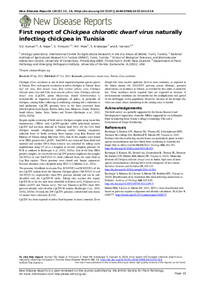First report of Chickpea chlorotic dwarf virus naturally infecting chickpea in Tunisia

Authors:
Chickpea (Cicer arietinum) is one of three important legume species grown in Tunisia. Five viral species are known to infect chickpea in Tunisia: Bean leaf roll virus, Beet mosaic virus, Beet western yellows virus, Chickpea chlorotic stunt virus and Faba bean necrotic yellows virus. Chickpea chlorotic dwarf virus (CpCDV, genus Mastrevirus, family Geminiviridae) is economically an important viral pathogens of pulses, in particular of chickpea, causing foliar yellowing or reddening, stunting and a reduction in seed production. CpCDV genomes have so far been recovered from infected plants from Egypt, Eritrea, India, Iran, Morocco, Oman, Pakistan, South Africa, Sudan, Syria, Turkey and Yemen (Kraberger et al., 2013, 2015a, 2015b).
Despite regular screening of field survey chickpea samples using tissue blot immunoassay (TBIA) with CpCDV-specific rabbit polyclonal antisera, CpCDV had not been detected in Tunisia until 2014. Of the 1133 field chickpea samples (displaying yellowing and/or stunting symptoms) collected from 43 fields covering three regions (Cap Bon, Bizerte and Mateur) of Tunisia during May-June 2014, four of the samples were found to be TBIA positive for CpCDV. Total DNA was extracted from dried leaf material and circular DNA from extracts was enriched by rolling circle amplification using 0.5 µl as a template to recover complete genomes by PCR as outlined in Kraberger et al. (2013, 2015a). Out of the four TBIA positive samples, we recovered two CpCDV genome amplicons for samples TuCP2524-14 and TuCP2525-14 (both collected from the same field in Cap Bon region). These genomes were cloned and Sanger sequenced. Pairwise identities were calculated using SDT v1.2 (Muhire et al., 2014). The genomes (GenBank Accession Nos. KT455051 and KT455052) of the two CpCDV isolates from the Tunisian chickpea plants (TuCP2524-14 and TuCP2525-14, respectively) share 99% pairwise identity and can be sub-classified into the CpCDV-H clade. Taking into account this report, CpCDV-H so far has only been identified in Eritrea (n=1), Pakistan (n=1), Sudan (n=107) and Tunisia (n=2). The two Tunisian CpCDVs share 96% pairwise identity with all other CpCDV-H isolates (Kraberger et al., 2013, 2015a, 2015b). Overall, the 209 CpCDV genomes (sub-divided into strains 13 strains) have a diversity of 21%.
CpCDV has been reported to infect food legumes in many countries. Even though this virus reaches epidemic level in some countries, as reported in the Sudan during the 2014/2015 growing season (Kumari, personal observation), its incidence in Tunisia, as revealed by this study, is relatively low. Virus incidence levels reported here are expected to increase if environmental conditions are favourable for the multiplication and spread of the leafhopper vector population. However, because of the damage this virus can cause, closer monitoring in the coming years is needed.
